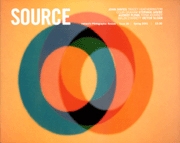An Awkward Proximity with Nature
'The Map' by Paul Seawright was at The Douglas Hyde Gallery, Dublin 30th January - 17th March 2001
Review by Fiona Kearney
Issue 26 Spring 2001
View Contents ▸
Paul Seawright's recent exhibition at the Douglas Hyde Gallery continues the artist's enquiry into the borderlands of contemporary society. The overtly political photographic series that defined Seawright's early career have been replaced by a more generic representation of space, the study of an intermediate ground caught between city, suburb and countryside. The photographs in The Map could have been taken anywhere in the Western World. The same concrete, earth and skeletal trees are to be found in every encounter between the rural and the built environment.
The images have been shot in Tallaght, a district of public housing estates on the outskirts of Dublin. It is an area that figures in the popular imagination as a poverty-stricken community with the attendant iconography of burnt-out cars, graffiti and ponies grazing on patches of green. It is perhaps not surprising then that Seawright chose to work here. His work often explores a liminal field on the edge of conventional narrative and he has found much to depict in Tallaght outside the stereotype of an Irish urban wasteland. The artist's fascination with this no-man's land is shared by other contemporary photographers, Jeff Wall for instance has also studied the peripheral sites of modernity. Seawright's work distinguishes itself, however, by its formal language - the images are almost monochromatic and in sombre greys and rich blood reds sensitively document the end zones of the modern metropolis.
This is a body of work that both captures a reality of Tallaght and puts forward a proposition of place - the gritty environment is not prettified and yet the artist achieves a rare beauty that avoids any sentimentalisation. A striking feature of the work in The Map is the absence of the human figure - there are only the remainders and traces of existence. We see human lights, litter and logos but never any people. The photograph is of course also a trace, an indirect encounter and Seawright has always privileged the oblique perspective as if to accentuate the indirect character of his medium.
Many of the photographs are taken in the early hours of the morning and the deep crimson colours that result imbue the images with a latent sense of violence. This sense of anxiety is heightened in several works by the chaotic presence of spindly branches pushing against the pictorial plane. Seawright seems to be placing the viewer in an almost awkward proximity with nature - every detail of branch, twig and bark are literally in your face - while simultaneously stressing the surface tension of the image. The effect produces both a sharp realism and a formalist abstraction, and seawright seems to be exploring a relationship for photography with non-figurative painting. The hectic patterns of interlinking boughs link the image to the frenzied compositions of Abstract Expressionism, in particular the drip paintings of Jackson pollock. However, the concentration of colour realised in the photographs relates the work to the sublime palette of colourfield artist, Mark Rothko. Seawright's photographs have a similar beauty and power to the Romantic modernism of such painters, an astonishing achievement given the significance of the documentary mode in his work.
The Map project was commissioned by South Dublin county council. As well as the photographs on show in the Douglas Hyde, the artist produced 20,000 copies of a colour publication of the work that was distributed free to homes in Tallaght and became a complimentary catalogue for the exhibition. Seawright felt that many of the local residents would not come to a gallery to see the exhibition and so instead felt it necessary to send the work to them, exploiting the reproductive possibilities of the photographic medium. The spare elegant hang of the work in the Douglas Hyde contrasts with the abundant numbers of rhe Map brochure made available. The exhibition will absorb the visitor but the amount of images in circulation will surely reinforce this otherworldly vision of Tallaght, Seawright's original perspective that magnificently places housing estates in the Romantic tradition of modern art.
Other articles by Fiona Kearney:
Other articles mentioning Paul Seawright:
Other articles on photography from the 'Documentary' category ▸






